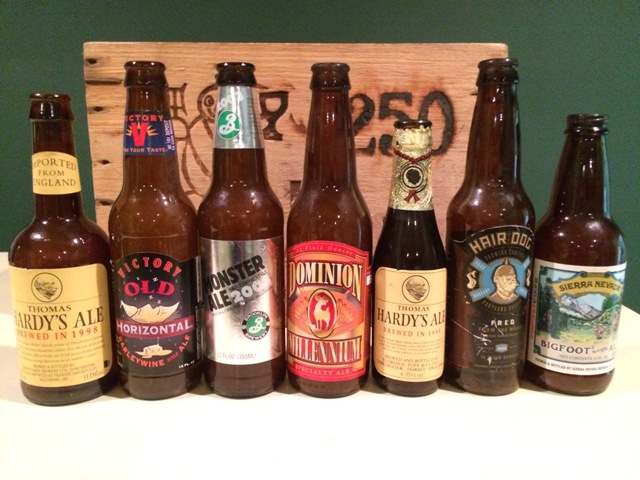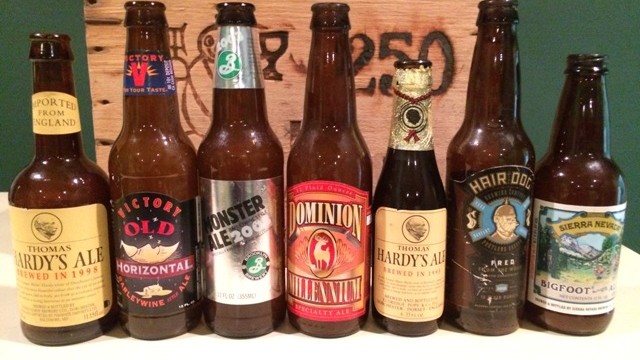By Diane Catanzaro and Chris Jones
There is an expression that some things get better with age. Examples of things that get better with age are many full-bodied red wines, those Levi jeans you wore in college, and us, the collective we, gain wisdom as we get older. Beer, for the most part, does not get better with age. But, there are exceptions.
While for most beers the maxim is “the fresher the better,” there’s a belief that some beers actually get better as they become “more seasoned,” particularly very strong, high alcohol beers like barleywines and old ales.
For homebrewing enthusiasts, if you look in the “Beer Judge Certification Program’s (BJCP) 2015 Style Guidelines” (which you can find at www.bjcp.org) English Old Ales (Category 17B) and English Barleywine (Category 17D) are two beer styles that may develop more complex flavor profiles as they get older. The ones we tasted were between 9.6-12% alcohol. The good folks from the BJCP indicate that for English Old Ales, “oxidative notes are acceptable, akin to those found in Sherry or Port”, while for an English Barleywine, “aged versions may have a sherry-like quality.” Oxidative? Sherry-like quality? Aged beer? What’s this all about? What makes this happen?
Oxidation. Our good friend, oxygen, the same gas that keeps us alive (that’s good) and can turn your steel car into rust (that’s bad) can interact with the constituents in beer and, like a molecular alchemist, turn them into something else. If you’re lucky, a barleywine or old ale can develop port or sherry-like aromas with a few years of aging in a cool cellar or under refrigeration. If you’re unlucky, the beer may develop the taste of wet cardboard, rotten vegetation, or worse yet, according to Lee W. Janson’s book “Brew Chem 101 – The Basics of Homebrewing Chemistry,” baby diapers. Ay carumba! That’s a flavor we’re hoping we don’t discover the next time we crack one open! How did the oxygen get in that bottle? Well, the beer could have been highly aerated when it was originally brewed and bottled, and as it ages in the bottle the oxygen impacts the flavor. And, if the crown cap isn’t perfectly airtight some oxygen may creep into the bottle.
With aging, a barleywine or old ale will often develop sherry or port-like notes from the oxidation process. English barleywines, like the Thomas Hardy’s, typically have intense, sweet caramel malt flavors, low carbonation, and very little hops flavor or bitterness. As these beers age, the oxidized notes that develop may be perceived as agreeable and adding complexity. The American barleywines have a similar flavor profile, but will have higher levels of bitterness from citrusy or piney American hops as well as more carbonation. As hops degrade over time there will be a less pronounced hops character, but a chance that off-flavors may develop. Also, carbonation will typically fade. Each bottle is an experiment, as the length and temperature of the aging will interact with the original beer in the development of the resulting flavor profile.
OK, so you’ve got a hankering for sherry-like flavors in your beverages, but you don’t want to make a trip to the ABC store to buy sherry or a vintage port, you’ve got some high-alcohol beers on hand, and you’ve got a few years to kill. Well, simply cellar the beers, wait years, and share them with your pinkies-out-Sherry-loving friends in a snifter, wine, or port glass. But how long do you let a barleywine or old ale age? In homage to Hot Tuna, how long must you have to wait, can you drink them now, or must you hesitate?
We can help. We descended down to our basement, the room where Chris’ brother Marty says “beers go to die,” and we found a stash of barleywines and an old ale that had not seen the light of day in years. Our friends Will and Jonna Walker have no cellar, but they’ve “first floored” several barleywines; they resurrected their beers from lying in state, and brought them over. We wiped the dust off the bottles, chilled them so they were cool but not cold (ideal serving temperature is about 57 degrees F) and busted them out to see how they’ve changed over the years, and to see whether we were sitting on stash of sherry or a bounty of baby diapers.
In the “really enjoyed them” category, the 1998 Thomas Hardy’s was a favorite, with notes of dried plum, apple, raisin, fruitcake, and caramel malt. It was sweet, complex, highly drinkable, and reminiscent of a tawny port. The 2005 Bigfoot was the only Bigfoot that still had a pronounced hops presence. It was smoky, raisiny, and hoppy as all get out (one of us thought the hop level was “tongue-curling”). The 2008 Hair of the Dog offering still rocked, with detectable levels of citrusy hops.
In the “enjoyed them” category, the 2004 Bigfoot had a very rich sherry-ish flavor, with hints of tobacco; Will and Jonna detected hints of prunes (or as the prune PR folks now say, dried plums). It had a higher level of residual sweetness than the 1999 Bigfoot; apparently time zaps the sugariness. We all found the 1999 Bigfoot to be smokier than the 2004.
In the “probably should have had them sooner” category, the 2004 Old Horizontal was malty with a restrained level of hops, but had degraded to the point of being a simple beverage, without a complex flavor profile. It had some carbonation, which most of the others did not. The 1995 Thomas Hardy’s was so highly oxidized that you either liked it or you didn’t, and there was not much middle ground. Chris said it wasn’t for him, but Jonna preferred it because it was more complex. Diane found it extremely pruney. The label indicates the beer “will last for 25 years”, and while that’s probably true, it may not exactly set your heart aflutter 25 years down the road. Glad we only aged it 20 years! The 2003 Brooklyn Monster was the ‘thinnest’ of the bunch, and over the years had lost its ferocity.
Remember, outside of the folks that make Thomas Hardy’s, most brewers make these barleywine and old ale style beers for you to enjoy them relatively soon, or at least within few years of purchase, not a dozen years later! It’s no knock on a brewery when you sip a 20-year old ale and say it’s missing something. You missed out by not drinking it sooner! However, some of these beers were tasty and the sherry-like oxidation that comes with age was very agreeable.
This was a fun experiment as we found the sherry-like oxidation added interest and complexity to these strong barleywine and old ale styles. And, most importantly, none of them tasted remotely like baby diapers.
| The Verdict
|
The Beers and Tasting Notes |
| Really enjoyed them! (1-4) | 1)1998 Thomas Hardy’s Ale (Thomas Hardy, Dorchester, England)
Flavors of tawny port, fruitcake, plum, raisins, fig. Highly drinkable.
2) 2008 Hair of the Dog, Fred, From the Wood Old Ale(Hair of the Dog Brewing Company, Portland, OR) Dark fruit, pleasant citrusy hops bitterness balance the sweet sherry notes, complex.
3) 1999 Millennium, (Dominion Brewing, Ashburn, VA) Molasses, hops bitterness, sherry-like notes.
4) 2005 Bigfoot Barleywine Style Ale (Sierra Nevada Brewing Co., Chico, CA) Balanced hops, dried fruit, raisins, caramel malt, hint of smoke, sherry. |
| Enjoyed them …. (5 & 6) | 5) 2004 Bigfoot Barleywine Style Ale (Sierra Nevada Brewing Co., Chico, CA)
Rich sherry-like aroma, very oxidized, intense prune flavor.
6) 1999 Bigfoot Barleywine Style Ale (Sierra Nevada Brewing Co., Chico, CA) Faintly smoky aroma, sweet but not as sweet as 2004, sherry, no hops.
|
| Probably should have had them sooner ….(7-9) | 7) 2004 Victory Old Horizontal Barleywine style ale (Victory Brewing Co., Downington, PA)
Floral aroma, restrained hops bitterness, sweet caramel malt, less complexity, oxidized sherry notes, some carbonation.
8) 2003 Brooklyn Monster Ale (Brooklyn Brewing, Utica, NY) Lighter-bodied, thin flavors, oxidation but little complexity.
9) 1995 Thomas Hardy’s Ale (Eldridge Pope, Dorchester, England) Prune, molasses, intensely oxidized, very sweet, pipe tobacco, muddy appearance.
|





